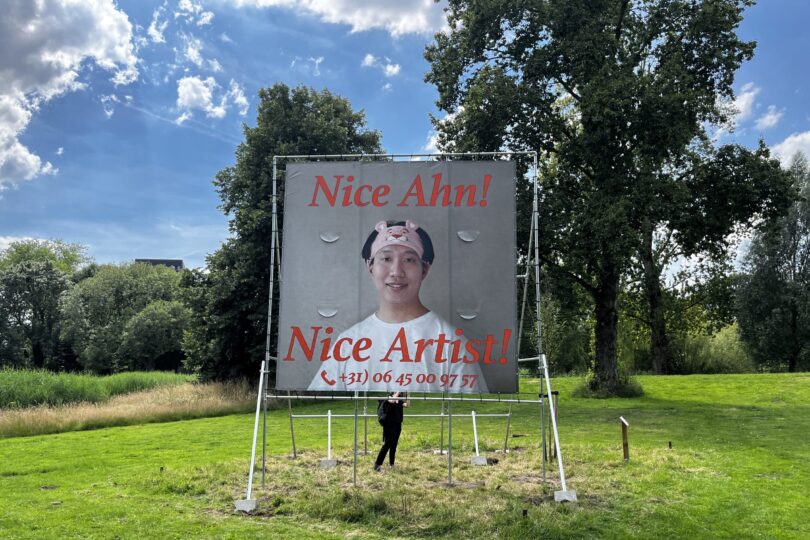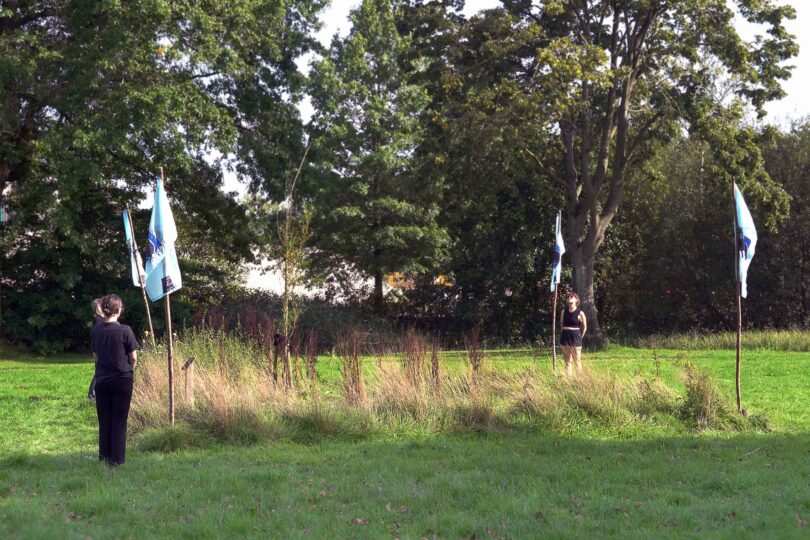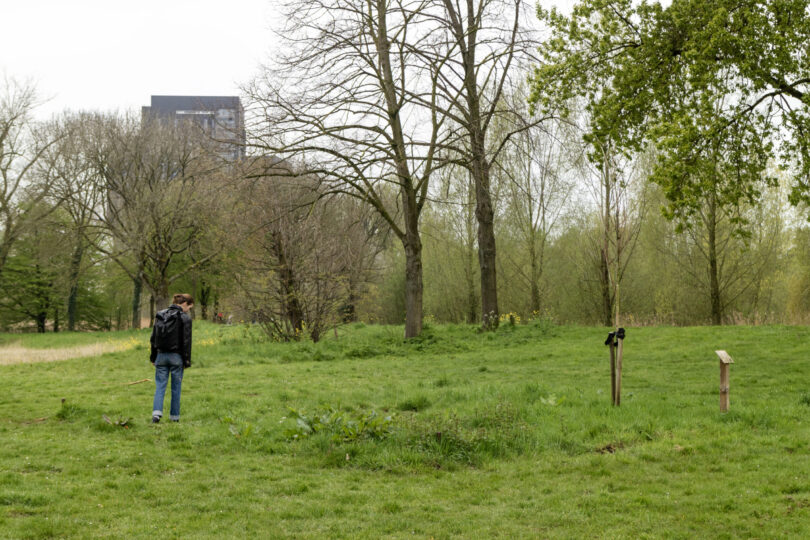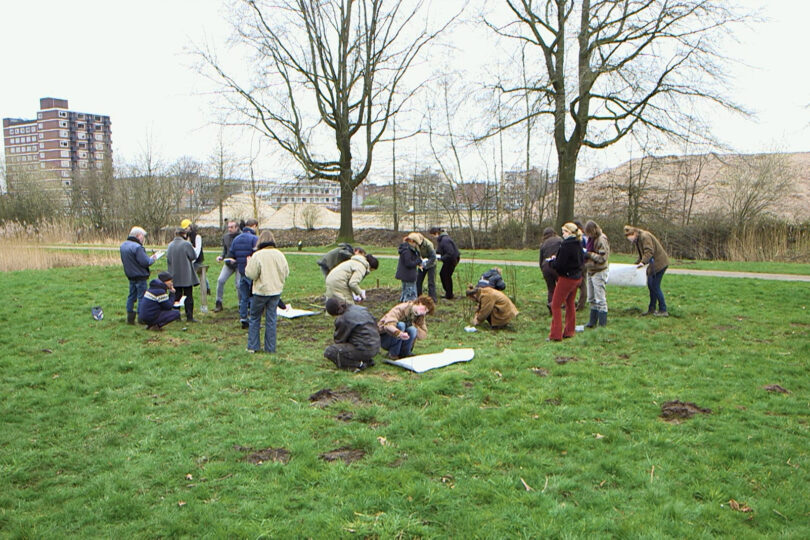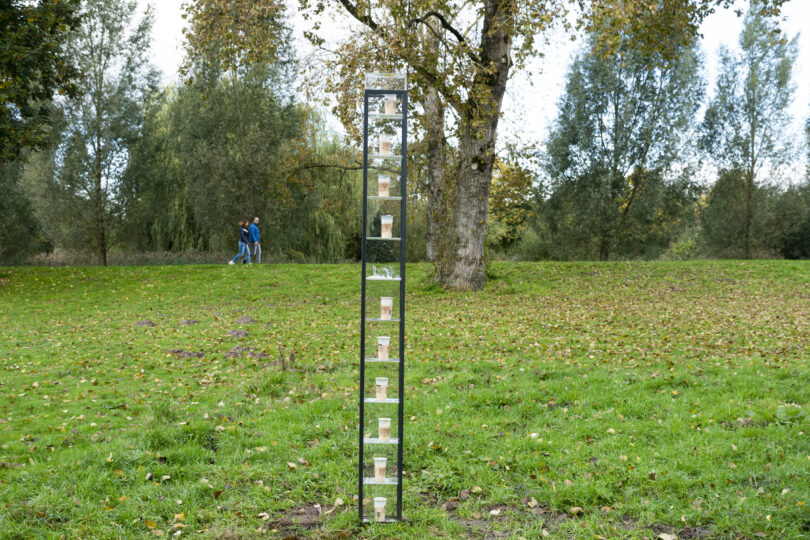The exhibition De Vrijstaat – land van 49m² presents the work of eleven artists who explore how freedom relates to space, regulation and ecology. Featuring work by Ahn Sung Hwan, Bo Emmens, Britte Koolen, Edward Clydesdale Thomson, Letizia Artioli, Maud van den Beuken, Maurik Stomps, de Onkruidenier, Penelope Cain, Sabina Timmermans and Urša Prek. The title of the exhibition refers to the project 49m², which laid its foundation, in collaboration with artist, social activist Gerrit-Jan Smit and the founder of 49m².
About 49m²
The project 49m² exists since 2016 and started with a unique agreement between artist Gerrit-Jan Smit and the Municipality of Breda. The contract states that a 7 by 7 metre piece of land in Zaartpark will remain untouched by the municipality for twenty years. As a result, anyone is free to intervene — except the government. This creates an exceptional situation: a piece of land without rules, where there are no rights or obligations, and where artists are free to place their work — a rare opportunity in our heavily regulated public space. This legal framework forms the foundation for an artistic free state, where ownership, freedom and responsibility in public space can be examined.
What began as a project with one artist has since 2020 evolved into a seasonal artist-in-residence programme hosted by Witte Rook. Each season an artist is invited to take charge of and observe the site over a period of three months, in relation to their own practice, the environment and passing visitors. Each artist approaches the residency in their own way, making 49m² a site of ongoing research, inspiration and experimentation.
A garden in the public space
A park can be seen as ‘A garden in public space’. However, where a garden often serves a single function, a park offers multiple purposes and meanings. The modern park originated in 1830s England and was intended to promote public health. These public places, accessible to everyone, are therefore also meeting places shaped by people, especially landscape architects. Today, pressing urban questions call into focus how these modified landscapes relate to contemporary ecological and social issues. Gerrit-Jan Smit’s success in persuading municipal officials that ‘ecology’ should be the guiding principle of the twenty-year experiment shows that 49m² transcends nature and art; it also raises questions about ownership, political power, regulation and the role of society in relation to these elusive green zones.
The Free State
These overlapping layers reflect the complexity of our society and so does Zaartpark, where 49m² is situated. As an ecological buffer zone between city and nature, it has the important function of a water overflow area; it is the stream valley of the Aa or Weerijs and meant to give the water’s floodplain area a bit of freedom. The free state of 49m² is limited to a (often soggy) patch of land, which many artists have claimed as their own during their season-long residency. And this is typically how we understand ownership: as the possession of land. But air and water are less clearly defined, more often controlled by measurement and data. Each artist adds their own observation to this 49m², collecting experiences and impressions like raw data. If we consider that the Dutch word park also refers to a “collection” such as a car park, industrial park or amusement park to which we can also add observatiepark (observation park).
Land van 49m2
By 2025, the project will be nearly halfway: nine years behind us, and the tenth year beginning in September. While the site itself shows little visible change, the world around it has accelerated dramatically: from the pandemic to the impact of war, increasing social polarisation, rising climate concerns and mounting pressure on public space. Though this 49m² holds no natural resources or strategic value, its symbolic worth has grown immensely: a place that belongs to everyone, yet to no one in particular — reminiscent of the historical meent, or common ground. In this way, 49m² becomes a research project, an artwork, a park, an ecological haven, and a free state where only those with a stake whether human, animal or plant have a voice. And at the same time, nothing really happens when you step over the steel border except perhaps that the place begins to spark your imagination.

Opening photographs by Stijn Terpstra
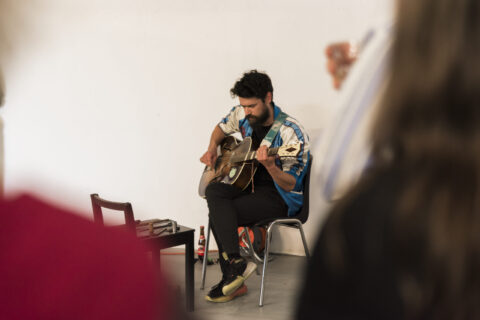

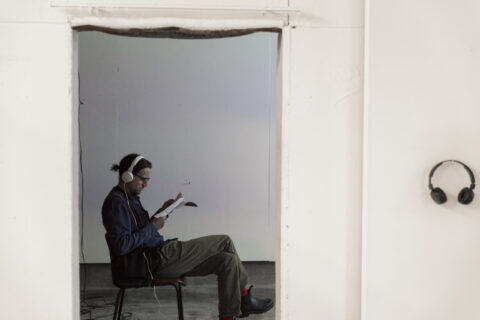
About the artists
The work of Ahn Sung Hwan reflects on the hidden primal instincts of contemporary society that persist beneath civilized behavior and political correctness. In search of the Miraculous (2025) appears to catch the wind and cut through the sea, instead fastened to the floor. In this state, the sail operates doubly: both as sail construction and brand surface, shifting between selfbranding and performativity.
Bo Emmens, winter resident of 2024, is a landscape draughtsman and performative researcher. During his residency at 49m², he founded a surveying society to professionally chart the plot. Cadastral Phenomenological Survey of 49 Square Meters (2024) – a sixty-minute video registration – is the result of this work. For the exhibition, he has collected and bundled his handwritten measurements.

Ahn Sung Hwan, In Search of the Miraculous (2025), photo Stijn Terpstra
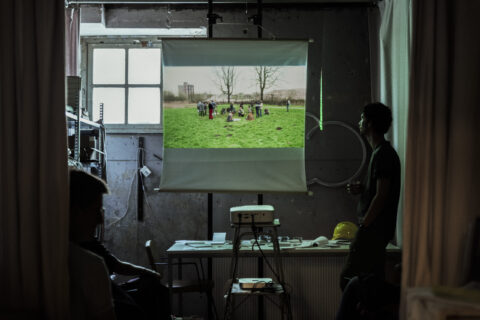
Bo Emmens, Cadastral Phenomenological Survey of 49 Square Meters (2024), photo Stijn Terpstra
Britte Koolen creates modular sculptures and installations that engage in a tactile dialogue with their surroundings. Stilte 1-6 (2024) emerged from her residency at 49m². As a continuation, she translated these drawings into sculptural form, resulting in the modular installation presented here. Rhythm, stillness, and silence are central to her work. With this piece, she explored how far she could push the repetition of the circle form: the installation contains more than one hundred hidden circles.
Edward Clydesdale Thomson is a visual artist who can be found in forests, heathlands, gardens, sailing rivers and seas – by boat, raft, or digitally. In the Onlanden he used a siren designed specifically for the site to record sounds, movements, and the presence of people. These were captured in short bursts using ten cameras and microphones. Edward selected and edited this material into a video portrait of the Onlanden.

Britte Koolen, Stilte 1-6 (2024), photo Stijn Terpstra
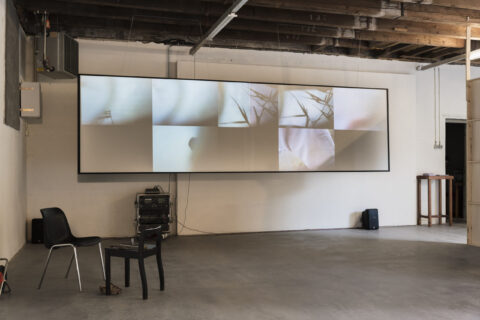
Edward Clydesdale Thomson, Siren (2023), photo Stijn Terpstra
Letizia Artioli investigates the relationship between humans and environmental data. Public Space is What Happens Between Soil and Clouds (2025), a two-hour sound installation, is the result of research into the invisible dynamics of public space as a boundless, data-rich environment. Each speaker–composed of dozens of recordings from 49m²–represents a distinct layer (soil, clouds, insects, birds, water). Together they form a complete orchestra and sonic landscape.
Maud van den Beuken explores physics, water management, and cartography, reflecting on them poetically. Mapping the Sky (2015-2018) is a cartographic investigation into mapping the sky itself. From the land, the sky above the Netherlands was captured at precisely the same times and locations. To do this, Maud travelled to eight different coordinates in the Netherlands, Belgium, Germany and the North Sea.

Letitzia Artioli, Public Space is What Happens Between Soil and Clouds (2025), photo Stijn Terpstra
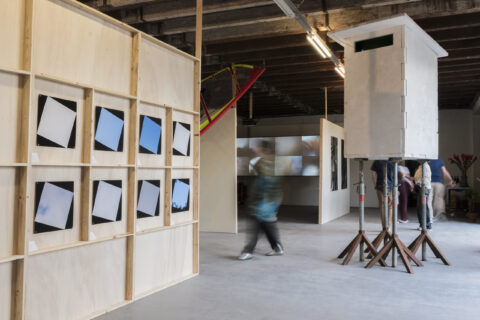
Maud van den Beuken, Mapping the Sky (2015-2018), photo Stijn Terpstra
De Onkruidenier – Jonmar van Vlijmen, Rosanne van Wijk, and Ronald Boer – developed a collective practice as a learning environment for the potential evolution of humans in relation to their surroundings. GRASSROOTS: Seeds for (x) change (2024) – a community art project created in collaboration with Tale of a Tub, Rotterdam – reflects on global systems by focusing on grasses in the district Spangen at a hyperlocal level. If we observe and examine the grasses in our environment more closely, can we then better care for our neighborhoods?
Penelope Cain shows in her video installation Think Like a Mountain (2020-2025) the largest glacier mass outside the polar regions. The video is part of a layered investigation and molecular-level mapping, bridging the distance between two molecularly linked sites–a colonial Spanish silver mine in Bolivia and a glacier in the remote Peruvian Andes–through a colonialera silver coin.

de Onkruidenier, GRASSROOTS: Seeds for (x)change (2024), photo Stijn Terpstra
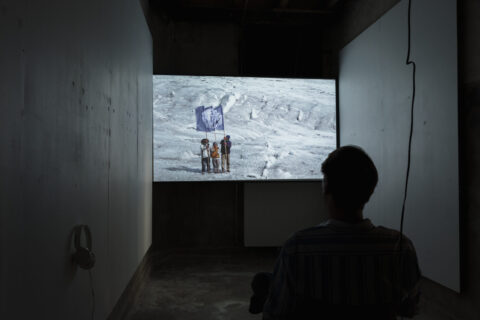
Penelope Cain, Think Like a Mountain (2020-2025), photo Stijn Terpstra
Sabina Timmermans investigates how we perceive, imagine, and assign meaning to nature. Our image of nature arises partly from direct, personal experiences with the landscape, but is equally shaped by our collective understanding, informed by cultural traditions such as art, literature, science, and spirituality. Through large charcoal drawings, spatial works, and paintings, she invites viewers to see landscapes as physical entities we can relate to with our own bodies.
Urša Prek is driven by a personal curiosity about what makes us who we are, primarily in terms of relative experience: generative histories, trivial memories, and their relation to space. Bear Witness (2022-2023) is inspired by the aesthetics of observation towers in Slovenia and embodies their layered structure. These towers are built to observe animals and serve as hunters’ posts across the forests; both safe havens and spaces of power–watching without being seen.

Sabina Timmermans, Roots 1 & Roots 2 (2023), photo Stijn Terpstra
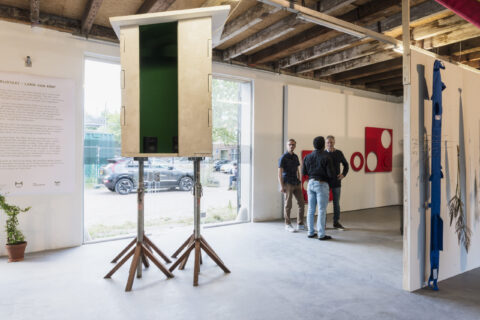
Urša Prek, Bear Witness (2022-2023), photo Stijn Terpstra

